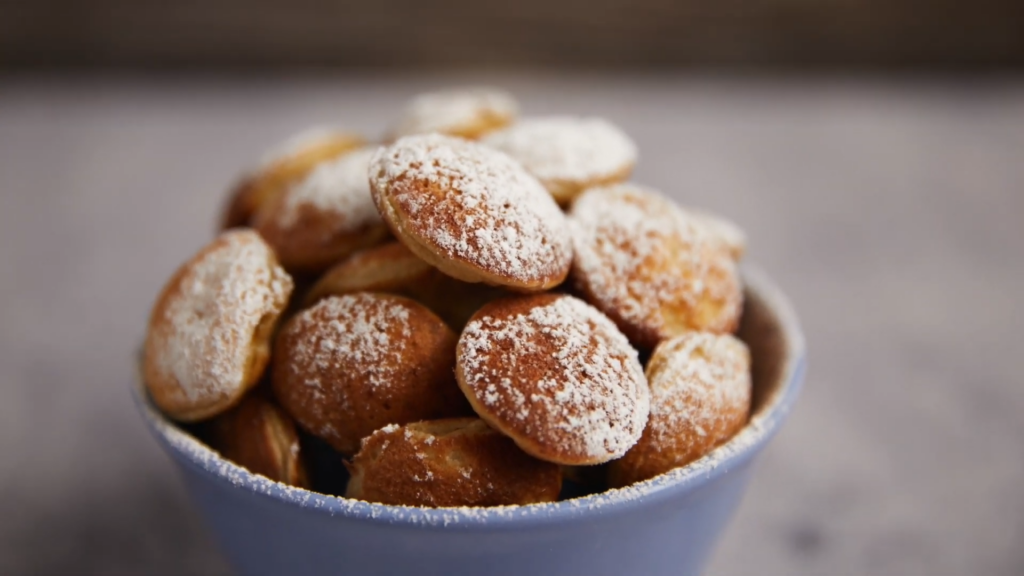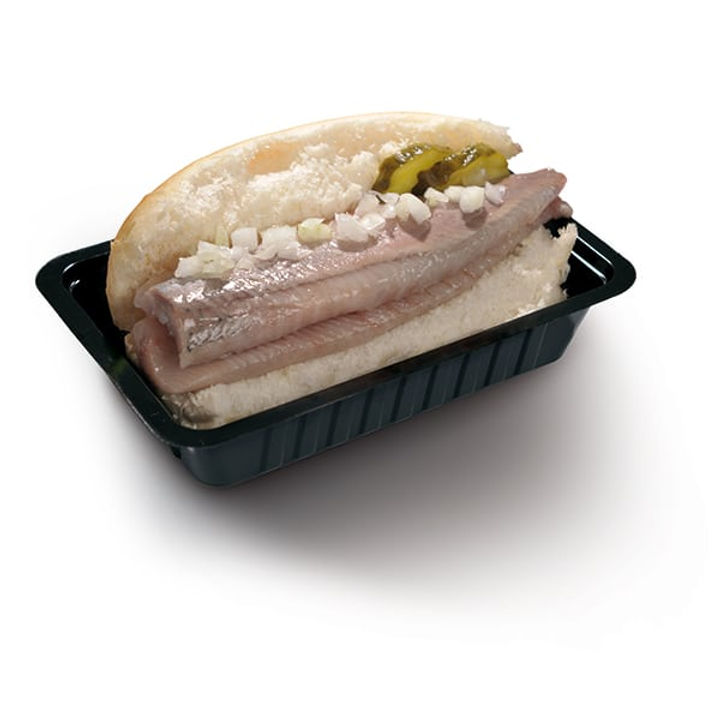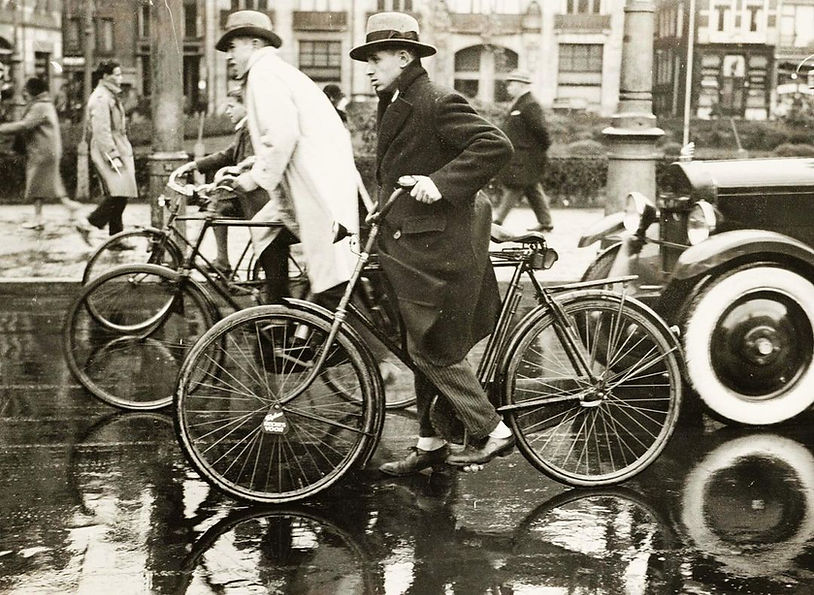
If you are craving something sweet and traditional, then desserts from the Netherlands are a must-try. Dutch sweets are known for their unique flavors and rich history, making them a delightful treat for any dessert lover. Today, we’ll explore six traditional Dutch pastries that showcase the best of Dutch pastry craftsmanship.
Traditional Dutch Pastries
With mini pancakes, pies and pastries galore, the Dutch are able to bake a rich, sweet and delicious snack. Dutch cuisine is often unfairly called ‘beige and bland’, but when it comes to traditional Dutch pastries, that is far from the truth. Think sugary, creamy, sugar and spice and all things nice. That is what makes Dutch pastries so delicious.
Together with the Dutch Expat Shop, we have compiled a list of all our favourite traditional Dutch pastries to help make sure that you do not miss out on a single treat. .
1. Poffertjes
Walk through any market or go to any fair or festival and you will find poffertjes. While they look like mini pancakes, poffertjes have a slightly darker flavour thanks to the yeast and buckwheat flour traditionally added to the mix. You need a special poffertjes pan to be able to make poffertjes. The poffertjes pan is usually made of cast iron and has small, poffertjes-sized, indentations in.
Poffertjes are usually served on little cardboard trays. They are covered with butter and powdered sugar. However, you can serve them with other toppings, such as whipped cream, strawberries, Nutella and syrup.
The catholic church claims to have invented this tasty little treat, which might explain the alternative name of ‘brothers’. There are, however, doubts about this claim. Something that is definitely true is that, due to colonialism, various forms of poffertjes are eaten around the world. For example, Kue Cubit from Indonesia are very similar to Dutch poffertjes.

2. Dutch Sugar Bread
Suikerbrood, or sugar bread in English, is a traditional sugary bread that hails from the Northern province of Friesland.The Friesian suikerbrood contains almost double the amount of sugar than sugar bread from other provinces in the Netherlands.
Sugar bread is made using a standard bread dough recipe with cinnamon, ginger syrup and sugar pearls mixed liberally through. Sugar bread should be moist and sticky to the touch. It is best served with lashings of butter for a creamy and sugary treat.
Sugar bread was traditionally given to new mothers after the arrival of a baby girl. The ginger syrup and cinnamon were believed to have a healing effect. If a mother gave birth to a baby boy, she was given a special raisin bread instead. Nowadays, you can find traditional sugar bread in bakeries and supermarkets in all parts of the country.

3. Dutch Apple Pie
The first recorded recipe of a Dutch Apple Pie comes from as far back as 1514, so, as you can see, this sweet treat has a long tradition in the Netherlands. The main ingredients of apple pie are a shell of thick pastry with a filling of sliced apple (usually a crisp and tart apple). Dutch apple pies usually contain lemon juice and cinnamon. They can also include numerous other flavours, such as almond paste, cardamom, ginger, nutmeg, clove or other spices.
Dutch Apple Pie comes in two main varieties, Appeltaart and Appelkruimeltaart. Appeltaart has a latticed lid made from strands of pastry. Appelkruimeltaart has a lid made using a crumbly mixture of oats, flour and butter. This gives it a more rustic look.
Apple pie is served best with whipped cream or ice cream. You can find apple pie in almost any bar or cafe in the Netherlands. It is the perfect sweet treat for any time of the day and with any drink.
To find a wider variety of pie or tart, the southern province of Limburg is the place to visit. Limburg has a strong tradition of vlaai – fruit pies and tarts. You can find vlaai in almost any flavour, including custard, cherry, apple, apricot and more.

Dutch Waffles
There are various sorts of waffles in the Netherlands, but the most famous are the Liège waffle and the stroopwafel.
4. Liège Waffle
When you walk through the streets of Amsterdam, the smell of waffles will drift to you from all over. The streets are lined with shops selling waffles covered in delicious goodies. Liège waffles are made with a doughy and dense brioche mixed with pearl sugar. It is cooked between two hot irons. Traditionally, they are eaten plain, as the sugar caramelises to give them plenty of flavour. However, nowadays, they are served with a range of sweet toppings, from banana and chocolate sauce to icing and M&Ms.
Liège waffles originate from Wallonia, the Flemish-speaking part of Belgium, but travelled to the Netherlands a long time ago. The Dutch word for waffle, wafel, was first noted in 1450. However, this word derives from an even older Middle Dutch word. Historians suggest that baking waffles between two hot irons goes as far back as the Bronze or Iron Age. Traditionally, they were eaten on New Year’s Eve or during other festivities and fairs. Throughout the city, bakeries would compete to have the best waffles. Luckily, nowadays, every day is a festivity if you want it to be!

5. Stroopwafel
Stroopwafels are one of the most famous Dutch treats. They are made of two thin and crispy waffle-like galettes stuck together with a gooey caramel. When you bite into a stroopwafel, you get a brilliant mixture of crunch, goo, sweet caramel, buttery biscuit and a slight hint of cinnamon. A top tip for eating stroopwafels is to let one rest over the top of a cup of tea so that it softens and tastes warm and sweet.
These delicious Dutch treats originated in Gouda in 1810 when a resourceful baker, Gerard Kamphuisen, decided to use his bakery leftovers to create a new treat. This created a treat that people with less money were able to afford to buy from the bakery. Because they were so cheap and tasty, they immediately became a hit, and by the 1870s, they had become a staple of Dutch households of all classes.
Nowadays, you can find Stroopwafels in any supermarket or convenience shop. They even sell them in vending machines at the train station. But you will find the best stroopwafels at the market, where they cook big, fresh and warm stroopwafels to order.

6. Oliebollen
Between November and December, Oliebollen stalls pop up all over, selling this traditional Yuletide doughy treat. On any street corner, you will find a stand selling oliebollen, krentenbollen and beignets to warm yourself up in the Winter.
Oliebollen are balls of sweet dough that are deep-fried and then covered in powdered sugar. They come in two main types, the oliebol, which is plain, and the krentenbol, which contains raisins. In recent years, less traditional oliebollen have started to appear, including oliebol with fillings such as apple and cinnamon, banana and chocolate and even coconut.These are more comparable to beignets but are rounder and the dough is a little heavier.
Oliebollen are thought to have first been eaten by Germanic tribes hundreds of years ago around the Yuletide. These were some of the deep-fried snacks offered to the Germanic Goddess Perchta. Perchta would fly through the sky at this time with other evil spirits, trying to cut the stomachs of people open. It was believed that the fat in treats such as oliebollen would make her sword slide across the bellies of those who ate them, thus saving their lives.

Nowadays it is tradition to eat oliebollen at any time during the festive period. They are an essential part of a Dutch New Year’s Eve celebration. In some households, it is tradition to hand make them during the day and then eat them at midnight. Other households prefer to buy them from the different bakeries and stands that sell them throughout the city. Wherever you get them from, they are a delicious and essential part of any New Year celebrations.
Where to Find the Best Dutch Pastries
You can find these delicious Dutch pastries at various cafes and market stalls across the Netherlands, especially at some of the best bakeries in Amsterdam. You can also find any of these treats at the supermarket too, in easy-to-make pre-mixed packages or ready to eat.
For Dutchies living outside the Netherlands, or even those within the country craving a taste of home, all the ingredients and pre-mixed packages for these treats can be found at the Dutch Expat Shop. There you can find all your favourite Dutch products and more. Better still, they deliver to over 200 countries, meaning you can enjoy Dutch treats almost anywhere in the world. Eet smakkelijk!













Comments
Hi there Dear, are you actually visiting this
web page regularly, if so after that you will absolutely obtain pleasant knowledge.
you’re really a good webmaster. The web site loading speed is amazing. It seems that you are doing any unique trick. Moreover, The contents are masterwork. you have done a magnificent job on this topic!
Precisely what I was looking for, appreciate it for posting.